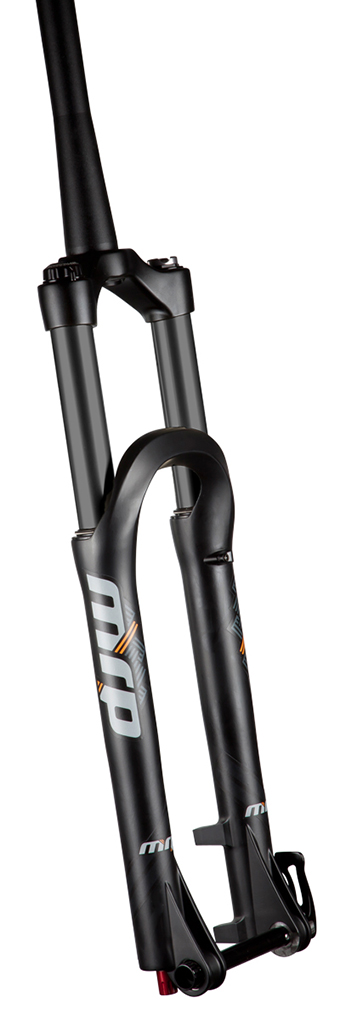
MRP Loop TR 29″ Fork
Wheel Size: 29”
Travel: 130mm
Offset: 49mm
Blister’s Measured Weight: 1854g (4.08lbs)
MSRP: $849
Bolted To: Evil The Following
Reviewer: 5’9”, 155 lbs.
Test Location: Whitefish, MT
Test Duration: 5 rides
Intro
Tom Collier took a look at the MRP Loop last summer, and a bit later in the fall I got a chance to play with the same fork. While Tom had the fork set up at 120mm travel on his hardtail, I figured I’d give the Loop a spin on my Evil Following, so I bumped the travel up to 130mm. This also meant that I was asking a bit more of the Loop – the Following likes to be ridden hard and fast, so it’s a good suspension workout. It also meant that the Loop was getting compared to the stock fork on the Following – a Rockshox Pike. More on that below.
If you haven’t read Tom’s review, do that first. He gets into the intricacies of the fork more than I do here, and ultimately I agree with him about pretty much all aspects of the fork.
The Chassis
Like Tom, I found that the Loop is a reasonably stiff fork, particularly for something with 32mm stanchions. I did get a noticeable amount of fore-aft flex out of it when smashing through rough trails, but I’d still say that it’s stiffer than any other 32mm fork that I’ve ridden. That said, when it comes to stiffness, it gives up quite a bit of ground when compared to the 35mm Pike. To be fair though, the Pike is far more comparable to the Loop’s bigger brother, the Stage. So the fact that I’m even bothering to make the comparison should be taken as a compliment to the Loop.
The 49mm offset on the Loop results in slightly better handling than something like the Rockshox Reba (46mm). By “better,” I mean that the steering is a bit less twitchy, and at the same time, less “floppy.” The front wheel is more inclined to hold a line with minimal input on the handlebars.

The Loop still has less offset that something like the Rockshox Pike (which has 51mm for the 29er version), but given that the Loop is more likely to find itself on 29ers with steeper head tube angles than the Evil, the 49mm offset seems like a good choice by MRP.
I rode the Loop in the 130mm travel configuration since that matched my Evil a bit better, but the Loop can also be run at 120mm and 140mm travel. The travel change requires taking the fork apart and swapping some spacers internally, but MRP includes some instructions and the process was pretty easy.
The Air Spring
The Loop takes a slightly different approach to the air springs used in forks these days. Like many other forks, the Loop has a positive and negative air chamber that aren’t independently adjustable – they automatically equalize when the fork is cycled. But unlike most other forks, the Loop is pressurized via the negative air chamber. So you pump up the negative chamber, pump the fork a bit, and the pressure equalizes into the (larger) positive air chamber. At the top of the left leg is a small bleed port – press the button, and it lets air out of the positive air chamber.
In practice, I found this system to be a bit annoying; I found I had to over pressurize the fork, cycle it a bit, pump it up again, cycle it again, and repeat maybe 4 times. And then at the end, I’d still have to bleed some air out while riding to get it dialed in. It’s not the end of the world, but it’s not nearly as easy as most other forks on the market.
The other noteworthy feature of the air spring is an external volume reducer – turn a knob at the top of the left leg and it reduces the positive air chamber volume, making the fork more progressive. I found this feature to work pretty well, although it doesn’t make a huge difference. I’d say it’s roughly the equivalent of adding 1.5 or 2 bottomless tokens in a Rockshox fork.
Like Tom found though, the ability to adjust volume on the fly was more of a novelty than a necessity. It’s not something that I found myself changing for different trail conditions.
Damping
The Loop has a rebound adjustment and a low speed compression adjustment, both of which I found to work well. Each “click” was well defined, and the amount of change between clicks was big enough that it made a difference, but not so big that I found myself wishing for a middle ground between clicks.
The low speed compression worked well to provide a bit of cornering and braking support in its lower settings, and effectively lock the fork out in its higher settings. While I didn’t use the lockout very often, I did run one or two clicks from fully open just to give the fork a bit more support.
NEXT: The Ride, Comparisions, Etc.
